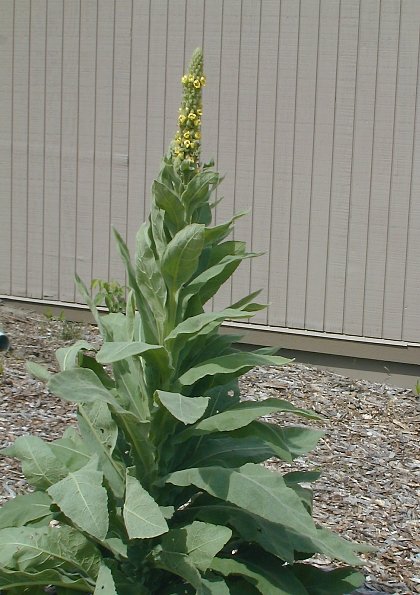Description: During the 1st year, this biennial plant consists of a rosette of basal leaves about 1-2' across. During the 2nd year, it becomes 3-7' tall and is usually unbranched. Occasionally, one or two side stems may develop in the upper half of the plant. These stems are covered with downy white hairs. The alternate leaves are up to 12" long and 4" across, becoming progressively smaller and more narrow as they ascend the central stem. They are obovate or oblong-ovate, smooth or slightly crenate along the margins (which are sometimes wavy), and covered with fine downy hairs. The lower leaves taper gradually to a narrow winged base, while the upper leaves are partially decurrent against the stem. The dense branched hairs provide the foliage with a color that is whitish or greyish green. The central stem terminates in a dense spike of flowers about ½–2' long. Each flower is about ¾" across and consists of 5 pale yellow petals, 5 hairy green sepals, 5 stamens, and a pistil. The 3 upper stamens are covered with white or yellow hairs, while the 2 lower stamens are hairless. The blooming period usually occurs during the summer and lasts about 1½ months. Only a few flowers are in bloom at the same time. Each flower is replaced by a seed capsule with 2 cells, each cell containing numerous little seeds. The rectangular-oblong seeds have fine wavy ridges and tiny pits across the surface. While the foliage withers away, the central stalk and its seed capsules turn brown and persist through the winter. The seeds are small enough to be carried aloft by the gusts of wind that shake the central stalk. The root system consists of a stout taproot that runs deep into the ground. This plant spreads by reseeding itself.

Cultivation:
Typical
growing conditions are full sun and mesic to dry soil that often
contains clay or stony material. The foliage is little bothered by
pests and disease, although some of the lower leaves may wither away
during a drought. The seeds can lie dormant in the soil for several
decades and remain capable of germination.
Range & Habitat:
Great Mullein is a common plant that occurs in all counties of Illinois
(see Distribution
Map). This plant is native to Eurasia, and it may have been
introduced
into the United States as an herbal or ornamental plant. Habitats
include limestone glades, rocky slopes and clay banks, pastures and
fallow fields, areas along railroads and roadsides, vacant lots, and
dry waste areas. Disturbed areas are preferred.
Faunal Associations:
Bumblebees are the most important pollinators of the flowers, where
they seek nectar and pollen. Other insect visitors, which seek pollen,
include Halictid bees and Syrphid flies. An unusual group of bees,
consisting primarily of Anthidium spp. (Carder
Bees) in North America, use the fuzzy hairs from the foliage as a
water-proof lining in their nests. The seeds of Great Mullein are too
small to be of much interest to birds, while the hairy foliage is
avoided by mammalian herbivores. Both the foliage and the seeds may
contain toxic compounds.

Photographic
Location:
A flower garden at Crystal Lake Park in Urbana, Illinois.
Comments:
Great Mullein is an imposing plant with interesting foliage and form.
The flowers seem small and inconspicuous in comparison with the rest of
the plant. This is an easy plant to identify, although there are other Verbascum
spp. (Mulleins) in the Old World that have a similar
appearance. Of these, only Verbascum phlomoides
(Orange Mullein) is known to occur in Illinois, although it is rare
within the state. This latter species has larger flowers (at least 1"
across) that range in color from pale yellow to orange-yellow. While
Great Mullein has dense spikes of flowers, the flowering spikes of
Orange Mullein are more interrupted and less dense. The leaves of
Orange Mullein are less hairy and more green on the upper surface, and
its upper leaves are only slightly decurrent against the stem. There
are other introduced Mulleins, but they are smaller and less hairy
plants that produce panicles or racemes of flowers, rather than spikes.
At one time, the dried stalks of Great Mullein were dipped in wax or
tallow and used as torches.